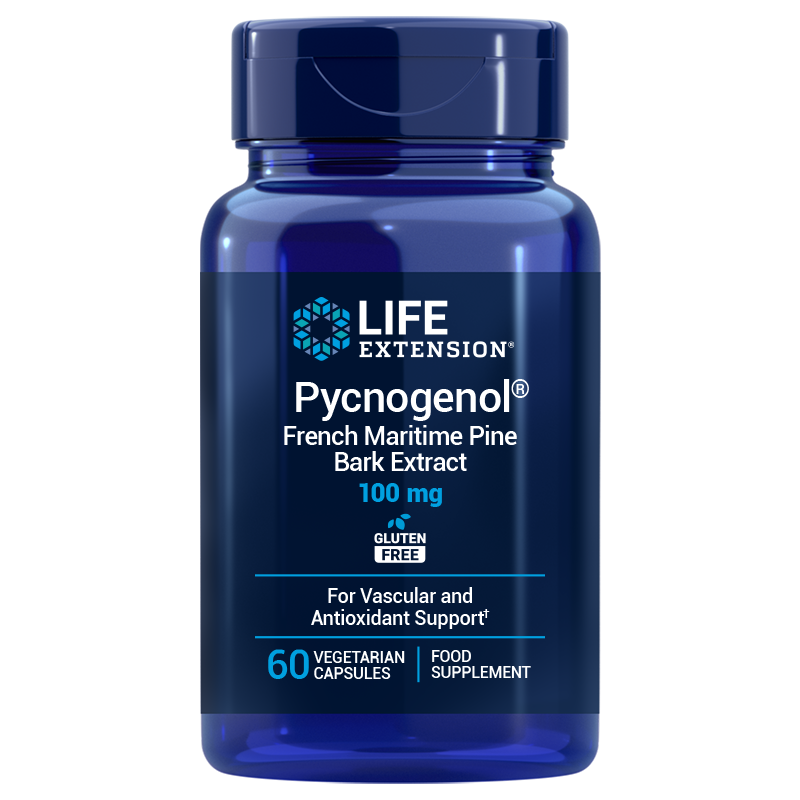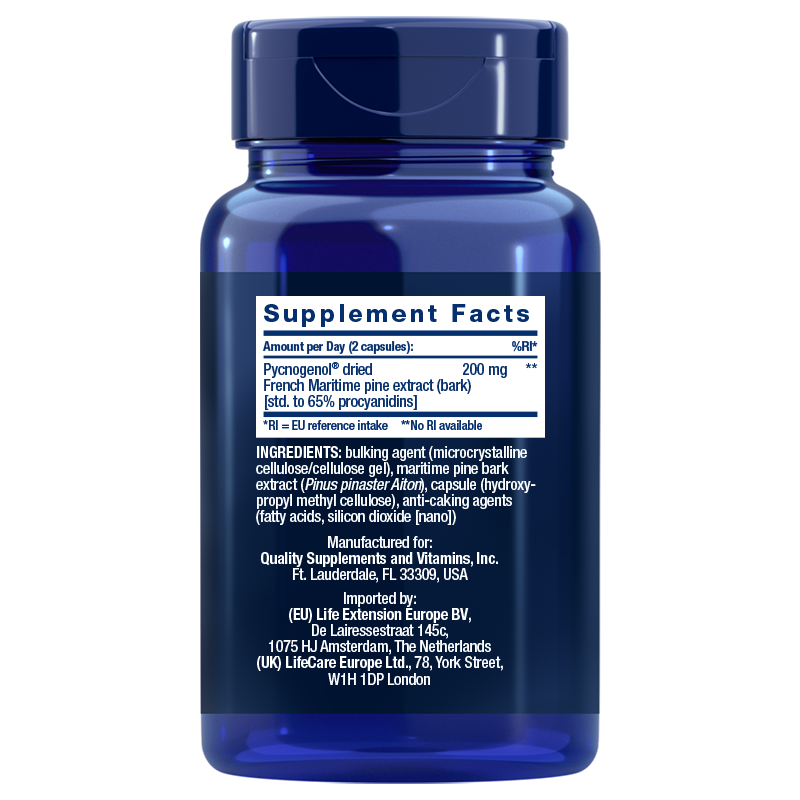Pycnogenol®, EU
Unique anti-aging extract for health and vascular support
Pycnogenol®, EU
Unique anti-aging extract for health and vascular support
For you, if you are interested in powerful antioxidant protection, anti-age and whole-body support
The ingredients in Pycnogenol® can:
- Promote healthy circulation
- Support vascular health
- Encourage a healthy inflammatory response
- Help maintain already-healthy blood sugar levels
Pycnogenol® contains procyanidins, flavonoids and other beneficial compounds that may help your body fight the effects of aging.

on orders over € 69
We have a 100 days return policy, not the standard 30 days!
Order before 11:00 CET, for same day shipping (Mon-Fri)
We can help you in 6 languages
Health benefits at a glance:
First of all, what is pycnogenol? Pycnogenol® is the trademark for a French maritime pine bark extract with powerful, scientifically validated benefits for longevity and overall health.
Pycnogenol® has a long history of clinical research. For a healthy heart, eyes, cells, DNA, and lifespan; there are few nutritional supplements that have been studied as extensively.
Why it works:
Pycnogenol®, French maritime pine bark extract, is shown to help the body fight normal aging by supporting vascular health and healthy circulation. (1-3)
It can also can provide powerful antioxidant protection and help prevent inflammatory factors to support whole-body health. (4-7)
The science behind the product:
Unlike other forms of pine bark extract, Pycnogenol® is a patented ingredient that has undergone extensive human clinical research over 40 years to substantiate its numerous anti-ageing properties.
Antioxidant and blood sugar support
Pycnogenol® has demonstrated an ability to help maintain already-healthy glucose levels. (8) It also may bolsters the body’s antioxidant defenses with powerful phytonutrient compounds, preventing the free-radical activity that can be damaging to cells, tissue, organs and DNA, as well as inhibiting stress on delicate vascular walls and more. (9)
Vascular health and healthy circulation
Pycnogenol® can support endothelial and arterial health by helping to prevent inflammatory factors called cytokines. It may also encourage healthy nitric oxide levels in the arteries, which can support endothelial function and arterial blood flow and has been shown to promote a healthy inflammatory response and platelet function. (10-13)
Available as a single-nutrient supplement
Life Extension believe in this extract’s health benefits so much that it has incorporated it into our arterial, circulatory and ocular health formulas, but you can also add Pycnogenol® to your supplement regimen with this stand-alone product.
How to use:
Please take according to the dosage and use guidelines under supplement facts, or as recommended by a healthcare practitioner.
Serving size: 1 capsule
Servings per container: 60
| Amount per day (2 capsules): | %RI* | |
|---|---|---|
| Pycnogenol® dried French Maritime pine extract (bark) [std. to 65% procyanidins] | 200 mg | ** |
*RI = EU reference intake **No RI available
INGREDIENTS:
Bulking agent (microcrystalline cellulose/cellulose gel), maritime pine bark extract (Pinus pinaster Aiton), capsule (hydroxypropyl methyl cellulose), anti-caking agents (fatty acids, silicon dioxide [nano])
non-GMO
Pycnogenol® is a registered trademark of Horphag Research Ltd. Use of this product may be protected by one or more U.S. patents and other international patents. Supported by over 40 years of research.
DIRECTIONS:
Take one (1) capsule once or twice daily.
WARNINGS:
Keep out of reach of children.
Do not exceed recommended daily dose.
Do not purchase if outer seal is broken or damaged.
Consult with your physician if you are undergoing treatment for a medical condition or if you are pregnant or lactating.
A food supplement should not be used as a substitute for a varied and balanced diet and a healthy lifestyle. Store tightly closed in a cool, dry place.
- Minerva Ginecol. 2017;69(1):29-34.
- Nutr Res. 2008;28(5):315-20.
- Phytother Res. 2019;33(2):276-287.
- DNA Cell Biol. 2016;35(11):730-739.
- Food Chem Toxicol. 2013;62:681-6.
- Free Radic Biol Med. 2012;52(4):765-74.
- Food Chem Toxicol. 2011;49(9):2196-201.
- Phytother Res. 2015;29(7):949-68.
- Fitoterapia. 2010;81(7):724-36.
- Phytother Res. 2014;28(3):348-62.
- Eur Heart J. 2012;33(13):1589-97.
- Hypertens Res. 2007;30(9):775-80.
- Life Sci. 2004;74(7):855-62



